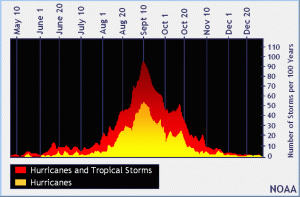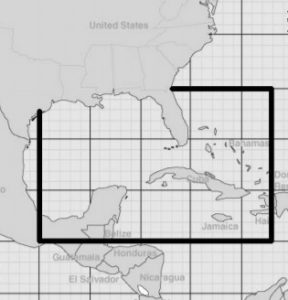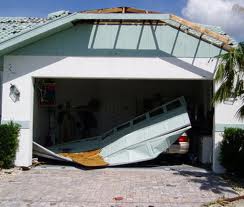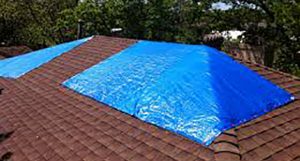

Hurricanes: What the Heck?
Tropical weather systems are once again in the headlines and at the forefront of millions of property owners’ and tenants’ minds, so it seemed like a good time to share some hurricane preparation for landlords and property managers!
A quick aside: Prior to my real estate career, I was once a county Emergency Management official in the Tampa Bay area, so I know a little about the meteorology, tracking, evacuations, government response, and aftermath of tropical storms and hurricanes. In yet another life, I was the Director of Risk Management for a local community college district, so I know a thing or two about risk management and insurance as well.
But the intent of this series is to fast forward through most of those boring details and get right down to the brass tacks of What does Hurricane Season mean for landlords and property managers?
Before I do so, I do want to make one key point here: A major hurricane making landfall in any specific location is an extremely rare event; But hurricanes are what we refer to as a low frequency / high impact event. They can have a catastrophic impact on a region, so it behooves us to be prepared.
The Atlantic Hurricane Season

The Atlantic Hurricane Season officially starts on June 1st, and officially ends on November 30th. It is rare (but not completely unheard of) to see tropical weather systems develop outside of this date range, mainly due seasonal meteorological trends such as sea surface temperatures.
Within that 6-month window of Hurricane Season, there are some trends worth noting:
Early in the season (June-July), it’s much more common for tropical storms to develop closer to Florida in the Gulf of Mexico or the Caribbean. These smaller, disorganized storms don’t usually pack the same punch as a major hurricane, but they can dump a ton of rain and storm surge in the area where they make landfall, causing localized flooding, school and government closures, and general chaos.
Later in the season (August, September, and early October) is when we tend to see storms developing far out into the Atlantic Ocean – some are tracked from as far away as the West Coast of Africa near the Cape Verde Islands. These large storms have plenty of time, and plenty of warm water in their path, which can allow them to develop into major hurricanes. In addition to severe winds of over 100mph, and massive amounts of rainfall, these massive storms can pack yet another punch with major storm surge inundation. These major storms from later in the season tend to the be the ones you’ve probably heard of, such as Andrew, Katrina, Ivan, Ike, and Sandy.
Preparing for Hurricane Season
Insurance
One of the most important things you can do to protect your financial interests is have a meeting with your insurance agent and make sure you have appropriate insurance coverages in place. Most homeowners policies come with a higher deductible for “named storm coverage” – you should know how much this deductible is for your policies and make sure you can cover it if needed.
In addition, some homeowners are surprised to hear that their homeowner’s insurance does not cover flood damage, or that their flood insurance (if they carry it) does not cover “wind driven rain”.
Bottom line: Spend a couple of hours hanging out with a good insurance agent and check on this stuff! It will be time well spent.

Another side note, and sort of an interesting quirk of doing business in real estate in the Southeast during hurricane season: Insurance carriers will not bind coverage, write any new policies, or make any changes to your policy when there is a named storm located in “The Box” – which, as the name implies, is simply a box drawn on the map by insurance giant Lloyd’s of London. If you have a real estate closing taking place during hurricane season, it can help immensely if you and your team are cognizant of this.
Roof
Aside from flooding, the other main threat from tropical storms and hurricanes is wind damage. We’ve all see videos of a home’s roof peeling off like the top of a sardine can in hurricane force winds. This phenomenon is actually caused by two things: poor uplift resistance of the roof itself, and wind penetration into other openings such as windows, doors, and garage doors. The wind basically makes a two-pronged attack on the roof: It pulls up on the roof from above, and pressurizes the attic and pushes up on the roof from below.

There are essentially two ways to mitigate this risk: 1) Increase the uplift resistance of your roof, and 2) Protect the exterior envelope of your home from wind penetration with impact rated windows, storm shutters, and other coverings.
Increasing the uplift resistance of your roof is, for the most part, something that was done to meet the current building codes when the building was constructed. In some cases, it is possible to retrofit your roof with tie down straps or “hurricane clips”, but in many cases, the areas where these need to be installed are extremely difficult or impossible to get to, or are best done during a total roof replacement.
Windows, Doors, and Other Openings
When it comes time to replace or upgrade your windows, you will likely find that your local building codes require you to install impact-rated windows, or (if not installing impact-rated windows), install approved storm shutters.
Impact-rated windows are a great investment, particularly on rental properties. Impact-rated windows require you, your tenant, or your property manager to do essentially nothing to prepare your windows for a storm: Shut the windows, and you’re done!
Conversely, you can buy the best storm shutters in the world, and they will do you absolutely no good if your panicked tenant or overworked property manager is unable to install them when needed. In addition, unless they are permanently installed, storm shutters tend to sit in the garage, attic, or shed for literally years between use. This can make them difficult to find, piece together, and install when the time comes (in addition to plywood, Home Depot and Lowe’s sell out of wing nuts every time a storm approaches – because we tend to lose the hardware for our storm shutters!)
Speaking of plywood – it’s a terrible material to use for storm shutters! It’s heavy, difficult to transport, store, and install, and it actually doesn’t meet the Florida Building Code missile impact test requirements for storm shutters. It amounts to a “better than nothing” solution.
Instead of plywood, consider purpose-made materials such as Fabric Shield or Storm Busters if you need to cover an opening. These are great for odd-sized openings such as gable vents and pet doors, or for non-impact rated openings such as sliding glass doors and French doors. They are lighter, better, and easier to transport, store, and install than plywood. As you probably already know, you will not find these awesome products on the shelf when a storm is approaching. It’s best to do these things whilst the sun is shining!
Garage Doors
Finally, don’t forget about the garage door. For most homes, the garage door is the single weakest point of entry for high winds. There are a few options here: 1) Install an impact-rated garage door, 2) Have your garage door professionally reinforced, or 3) Cover the opening with one of the products mentioned above, such as Fabric Shield.

Pre and Post Landfall
Note: Many of the recommendations below require an open line of communication with your tenants. I cannot overstress the importance of having current, accurate contact information for each or your tenants. An annual update of contact (and secondary/emergency contact) information for all tenants is certainly a best practice!
Pre-Landfall Issues and FAQs
If there’s one thing I learned during the approach of Hurricane Irma in 2017, it’s that your tenants will have tons of questions as a hurricane approaches! I’ve listed some of these frequently asked questions, along with my recommended responses, below:
Is our property in an evacuation zone? Does the evacuation order apply to us?
While this is something you should know about your properties as a landlord or property manager, it’s also something your tenants should know, regardless of where they live. Each county maintains a website where you can look up your evacuation zone, as well as color coded maps which depict the different hurricane evacuation levels/zones.
Remember: hurricane evacuation levels can and do differ from flood zones!
What should we do? Should we evacuate?
Whether they are in a designated evacuation zone or not, your tenants will want you to tell them what to do. My advice is: Don’t give advice. Even if your advice is accurate and well-intended today, the situation, and the official guidance from government officials, could change tomorrow.
Rather than giving specific advice or instructions, instruct your tenants to follow the instructions of their local emergency management officials for preparation tips, shelter lists, and evacuation info.
Can we/Should we board up our windows? And do we have to pay or it?
We discussed the benefits of impact rated windows and storm shutters above. Whether you have these or not, your tenants will feel the need to do something to protect their belongings, and many will ask you if they can board up their windows.
In most cases, there is probably very little harm in letting your tenants board up their windows. It gives them something proactive to do, makes them feel better prepared, and could very well ending up protecting your property and their belongings from storm damage. In some cases, we’ve even reimbursed tenants for the cost of supplies. I would, however, caution tenants against climbing ladders or trying to board up second-story windows.
Can we defer our rent payment?
Depending on the time of month, your tenants may have very legitimate reasons for spending their rent money on disaster preparedness supplies and other necessities such as non-perishable foods and prescription medications, or evacuation-related expenses such as lodging and fuel. As a landlord or property manager, it may help to consider this in advance and develop a policy on rent deferment and suspension of late fees and other penalties during an emergency.
Post Landfall Issues
Up to this point, we’ve really only discussed how to prepare for a storm. But what happens after the storm passes?
Damage Assessment – Immediately following a storm, your first priority should be damage assessment and making contact with each of your tenants. At a minimum, we’ve found it useful for you or your property manager to drive past each property, snap a quick photo to confirm the condition of the property, and make contact with the tenant to ensure there are no problems that weren’t visible from the street (such as roof leaks, electrical, or plumbing issues).
By far the most common damage from hurricane Irma was damaged fencing. A close second was downed tree limbs. Fence contractors and tree trimming companies were still busy from storm damage, even a year after Irma!
Insurance claims – If your property sustained significant damage (and it looks like it will cost more than your named storm deductible to repair it), then you should consider starting the insurance claim process as soon as possible. Yours will be one of perhaps thousands of claims being processed, and submitting your claim a day or two ahead of others can make weeks of difference on the back end.
Repairs – In some cases, it may be necessary to make temporary repairs while waiting on insurance claims and/or contractors. The most common temporary repair by far is the infamous blue tarp to cover roof damage (which can be a critical step in preventing further water intrusion and additional damage to your property). Other common temporary repairs may include coverings for broken windows and temporary fencing.

Longer-term, you’ll want to work with your insurance adjuster (if applicable) and/or contractors to ensure the permanent repairs are permitted and meet all current building codes. Municipalities also tend to crack down on unlicensed contractors following a major storm, so be careful to vet your contractors carefully for licensing and insurance to avoid any unnecessary hassles and delays.
Rent Collections – As mentioned above, your tenants may have exhausted their rent money and/or savings on storm preparation and evacuation, and will have likely missed work due to the storm because of closures and evacuations. It helps immensely to have a plan in place ahead of time for waiving late fees and/or deferring rent payments, if applicable.
Vacancies and Abandonment – While we did not face this problem following Irma, there are plenty of horror stories following major storms such as Andrew and Katrina of tenants evacuating, and then simply never returning. There can be several legitimate reasons for this – a tenant may have been planning to move anyway, and the storm just expedited their plans; Or the tenant may simply not have enough money to return, or an employer to return to, so they decide to stay with their friends or relatives longer than planned.
In such a situation, it is crucial to understand State laws concerning abandonment and possession. In all cases, it’s better to communicate with the tenant and document any early lease terminations in writing. Taking possession of a unit or disposing of a tenant’s possessions prematurely can have severe repercussions for landlords. Be sure to consult with your property manager and an attorney before doing so.
The Off Season
November 30th marks the official end of hurricane season each year. But this is not the time to rest on your laurels! Rather, the “off season” is a great time to check up on your insurance policies, and inspect your property for issues such as tree trimming or other exterior repairs that might be needed.
The winter months are also an ideal time to schedule upgrades such as window replacements and installation of storm shutters (as you can imagine, these guys tend to get busier the closer we get to hurricane season).
Resources
I hope this series of posts has given you some food for thought with regards to preparing your rental properties for hurricane season. If you have other burning questions about something I didn’t address, please leave a comment below!
In closing, I wanted to share some additional resources I’ve learned to rely on over the years:
The National Hurricane Center – The National Hurricane Center is a component of NOAA and is the official source for hurricane forecasting. In short, the NHC shares their forecasts with the media, and the media is supposed to disseminate the information to the public. As we all know, some media outlets like to sensationalize the news in order to increase their ratings. So, it’s nice to be able to get the unfiltered version from the NHC at times.
Your Local National Weather Service Office - Similar to the National Hurricane Center, your regional National Weather Service Office provides an unbiased analysis of severe weather forecasts and impacts on your local area, and is responsible for issuing Watches and Warnings for severe weather.




Comments